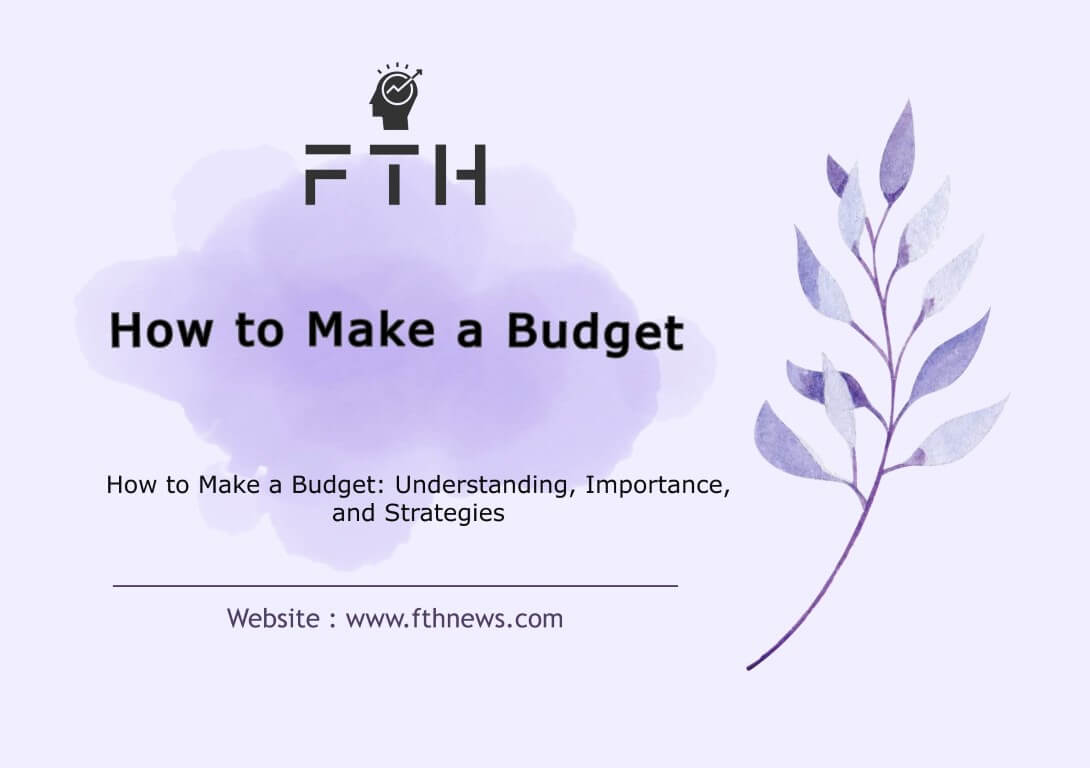
How to Make a Budget: Understanding, Importance, and Strategies
In today’s fast-paced world, managing your finances effectively is crucial for achieving financial stability and reaching your financial goals. One of the foundational steps in financial management is creating a budget. If you’ve ever wondered, “How to Create a Budget,” you’re in the right place. In this comprehensive guide, we’ll walk you through the essential steps to help you gain control over your money and set yourself up for financial success.
What Is a Budget?
A budget is a detailed financial plan that outlines an individual’s or organization’s income and expenditures over a specific period. It serves as a roadmap for managing financial resources, ensuring that money is allocated efficiently to meet various needs and goals. The primary purpose of a budget is to provide a clear overview of how income is earned, spent, and saved, allowing for better financial control and decision-making.
Understanding the Importance of Budgeting
Budgeting isn’t just about numbers; it’s a powerful tool that can shape your financial present and future. It’s the cornerstone of effective money management and a key to achieving your financial goals. Let’s delve into why budgeting matters and how it can positively impact your financial well-being.
1. Financial Awareness:
Budgeting gives you a clear picture of your financial landscape. It helps you understand how much money you have coming in and how much you’re spending. This awareness empowers you to make informed decisions and prevents surprises that can lead to financial stress.
2. Goal Setting:
Budgeting aligns your spending with your goals. Whether you’re saving for a dream vacation, buying a home, or paying off debt, a budget enables you to allocate funds toward your priorities and track your progress.
3. Control Over Spending:
Creating a budget means assigning specific amounts to different expense categories. This control over spending prevents impulsive purchases and ensures that you’re living within your means.
4. Debt Management:
A budget is a powerful tool for managing debt. It allows you to allocate extra funds toward debt repayment, accelerating your journey toward becoming debt-free.
5. Savings and Emergency Funds:
Budgeting makes room for savings. You can allocate a portion of your income toward short-term and long-term goals, as well as building an emergency fund. This financial cushion can prevent you from relying on credit when unexpected expenses arise.
6. Smarter Financial Choices:
With a budget, you can evaluate spending choices based on your financial priorities. It prompts you to ask whether a purchase aligns with your goals and values.
7. Avoiding Overspending:
Without a budget, it’s easy to overspend on discretionary items. Budgeting helps you set limits and prioritize needs over wants.
8. Tracking Progress:
A budget serves as a tracking tool. You can monitor your spending habits and assess whether you’re staying on track with your financial goals. Adjustments can be made as needed.
9. Financial Confidence:
Successfully managing your finances through budgeting boosts your confidence in handling money matters. It’s empowering to know that you’re in control of your financial destiny.
10. Long-Term Financial Success:
Budgeting isn’t a short-term fix; it’s a lifelong habit. Over time, budgeting can lead to wealth accumulation, financial stability, and a secure retirement.
11. Relationship Management:
For couples or families, budgeting fosters open communication about financial matters. It ensures that everyone is on the same page and working toward shared goals.
Budgeting is the compass that guides your financial journey. It provides clarity, control, and direction to your money management. By understanding where your money is going and making intentional decisions, you can achieve your financial aspirations while building a strong foundation for lasting financial success. Remember, budgeting isn’t restrictive—it’s a tool that empowers you to live a life that aligns with your values and dreams.
How to Make a Budget:
Crafting a budget is like putting together a financial puzzle that helps you manage your money, achieve your goals, and pave the way for a stable future. Follow these steps to create an effective budget that aligns with your financial aspirations and empowers you to take control of your finances.
Step 1: Determine Your Financial Goals
Identify your short-term and long-term financial goals. Whether it’s paying off debt, saving for a vacation, or building an emergency fund, your goals will shape the allocation of your funds in your budget.
Step 2: Calculate Your Income
Compile all sources of income, including your salary, wages, side gigs, investments, and any other money you receive regularly. Calculate your total monthly income.
Step 3: List Your Expenses
Categorize your expenses into fixed and variable categories. Fixed expenses, like rent, mortgage, and insurance, remain constant each month. Variable expenses, such as groceries, entertainment, and dining out, may fluctuate.
Step 4: Track Your Spending
For a month, keep track of your spending habits. Collect receipts, review your bank and credit card statements, and record every expenditure. This will provide insights into your current spending patterns.
Step 5: Organize Your Expenses
Categorize your tracked expenses to align with your budget categories. This will help you see where your money is going and identify areas where you might need to make adjustments.
Step 6: Set Spending Limits
Set limits for each expense category based on your financial goals and income. Ensure that your total expenses do not exceed your total income.
Step 7: Allocate Savings and Debt Payments
Prioritize saving and debt repayment in your budget. Allocate funds for emergency savings, retirement contributions, and paying down debts, with a focus on high-interest debts.
Step 8: Create Your Budget
Using a spreadsheet or budgeting app, input your income and allocate the specified amounts to each expense category. Ensure that you account for all your expenses and savings goals.
Step 9: Monitor and Adjust
Regularly track your spending against your budget. If you find that you’re overspending in certain areas, adjust your allocations to bring your budget back on track.
Step 10: Review and Reflect
At the end of each month, review your budget. Assess whether you stayed within your allocated amounts and reflect on your progress toward your financial goals.
Step 11: Be Flexible
Life is dynamic, and your budget should be adaptable. Unexpected expenses or changes in circumstances may require adjustments to your budget. Be flexible and willing to revise your allocations as needed.
Step 12: Maintain Discipline
Stick to your budget and exercise discipline in your spending habits. A budget is a tool that empowers you to make intentional choices, so stay committed to your financial goals.
Remember, creating a budget is a personalized process. It’s about finding a balance between your income, expenses, and goals. By following these steps and consistently tracking your progress, you’ll gain financial clarity, reduce stress, and take significant steps toward achieving your financial dreams.
Tracking and Adjusting Your Budget:
Creating a budget is just the beginning of your financial journey. To truly harness the power of budgeting, you must regularly track your spending, evaluate your progress, and make necessary adjustments. Here’s how you can effectively track and adjust your budget to stay on the path of financial success.
Regularly Monitor Your Spending
- Keep Records: Continuously track your expenses by documenting every purchase, payment, or transaction. Collect receipts, review bank statements, and use budgeting apps to log your spending.
- Compare to Your Budget: Regularly compare your actual spending to the budget you’ve set. This will give you insights into whether you’re staying within your allocated amounts.
Analyze Your Spending Patterns
- Identify Variations: Look for patterns in your spending. Are there any categories where you consistently overspend or underspend? Identify areas that might need adjustment.
- Unplanned Expenses: Factor in unexpected expenses that may have arisen during the month. This will help you understand their impact on your budget.
Evaluate Your Progress
- Assess Your Goals: Review your progress toward your financial goals. Are you on track to achieve them? If not, assess what changes might be necessary.
- Reflect on Achievements: Celebrate milestones and achievements, even small ones. This positive reinforcement will motivate you to continue adhering to your budget.
Make Necessary Adjustments
- Trim Excess Spending: If you consistently exceed your allocated amounts in certain categories, consider cutting back. Look for areas where you can reduce unnecessary spending.
- Shift Priorities: If your financial goals change or evolve, adjust your budget accordingly. Allocate more funds to new goals and less to areas that are no longer a priority.
- Emergency Fund: If you had to dip into your emergency fund due to unexpected expenses, replenish it as soon as possible to maintain your financial safety net.
Implement Changes
- Update Your Budget: Based on your analysis and adjustments, update your budget. Revise the amounts allocated to each category to reflect your new financial strategy.
- Maintain Consistency: Stick to your revised budget and make a conscious effort to spend according to your adjusted allocations.
Review Regularly
- Weekly Check-Ins: Conduct weekly or bi-weekly check-ins to review your spending and make small course corrections as needed.
- Monthly Deep Dive: At the end of each month, perform a more comprehensive review. Analyze your spending patterns, evaluate your progress, and refine your budget.
Stay Adaptable
- Life Changes: Life is dynamic, and circumstances can change. Be prepared to adjust your budget if you experience changes in income, expenses, or financial goals.
- Personal Growth: As your financial literacy grows, you may discover new strategies and tools to optimize your budget. Don’t hesitate to incorporate these insights into your approach.
Remember, tracking and adjusting your budget isn’t a one-time task—it’s an ongoing process. Consistently monitoring your finances, analyzing your habits, and adapting your budget to your evolving needs will ensure that you’re making the most of your financial resources and progressing toward your goals.
Budgeting Strategies: The 50/30/20 Rule and Beyond
Budgeting methods are diverse, catering to different financial goals, lifestyles, and preferences. The 50/30/20 rule is one such popular budgeting method, but there are others worth considering. Let’s explore the 50/30/20 rule and a few additional budgeting methods:
50/30/20 Budgeting Rule:
Essence: This rule suggests allocating your after-tax income into three categories:
50% for Needs: Essential expenses like housing, utilities, groceries, and transportation.
30% for Wants: Non-essential but enjoyable expenses like dining out, entertainment, and hobbies.
20% for Savings and Debt Repayment: This includes savings, investments, and debt repayment.
Benefits: Provides a simple and flexible framework for budgeting, ensuring a balance between essential expenses, discretionary spending, and financial goals.
Zero-Based Budgeting:
Essence: Every dollar earned is assigned a specific purpose, with the goal of “zeroing out” the budget, meaning income minus expenses equals zero. This method requires assigning all income to expenses, savings, or debt repayment, leaving no money unallocated.
Benefits: Promotes conscious spending, encourages prioritization of financial goals, and provides a clear picture of where every dollar is going.
Envelope System Budgeting:
Essence: Cash is divided into envelopes designated for specific spending categories (e.g., groceries, entertainment). Once an envelope is empty, spending in that category stops until the next budgeting period.
Benefits: A tangible and visual way to control discretionary spending, promoting discipline and preventing overspending in specific categories.
The 80/20 Rule:
Essence: Similar to the 50/30/20 rule, but with a higher allocation toward discretionary spending. It suggests allocating 80% of income to essential expenses and savings while allowing 20% for discretionary spending.
Benefits: Provides a more conservative approach to discretionary spending, ensuring a larger portion of income goes towards essential needs and savings.
Pay Yourself First:
Essence: Prioritize saving by allocating a fixed percentage of your income to savings or investments before budgeting for other expenses.
Benefits: Ensures that savings are not an afterthought and encourages a consistent and disciplined approach to building wealth over time.
Bi-Weekly Budgeting:
Essence: Adjusts budgeting to a bi-weekly schedule, aligning with many individuals’ pay cycles. This method involves allocating expenses and savings based on two paychecks per month.
Benefits: Matches budgeting with income frequency, making it easier to manage cash flow and expenses.
The Anti-Budget:
Essence: Focuses on tracking and controlling spending without rigid categories or detailed planning. It emphasizes awareness and mindfulness about spending habits.
Benefits: Allows for flexibility and adaptability, suitable for those who find traditional budgeting methods too restrictive.
Choosing the right budgeting method depends on individual preferences, financial goals, and lifestyle. Experimenting with different approaches or combining elements from various methods can help tailor a budgeting strategy that aligns best with specific needs and circumstances.
Tools and Apps for Budgeting:
In today’s technologically advanced landscape, budgeting has been made more accessible and efficient through a myriad of user-friendly tools and apps. Let’s explore these digital aids and delve into how technology can revolutionize your budgeting experience.
- Intuitive Budgeting Apps:
- Example: Mint, YNAB, and PocketGuard.
- These apps offer features like expense tracking, budget creation, and financial goal setting. They sync with your accounts, providing real-time insights into your spending patterns and helping you stay on top of your financial goals.
- Automation and Integration:
- Insight: Syncing Your Finances.
- Many budgeting tools integrate seamlessly with bank accounts and credit cards, automating the process of categorizing transactions. This not only saves time but also ensures accuracy in tracking your income and expenditures.
- Expense Analysis and Reporting:
- Insight: Visualizing Your Financial Health.
- Modern budgeting apps often come with sophisticated reporting features. Visualizing your financial data through charts and graphs makes it easier to identify trends, areas for improvement, and celebrate your financial victories.
- Goal Tracking and Alerts:
- Example: Qapital, Chime.
- Some apps allow you to set specific savings goals and send alerts when you’re nearing or surpassing budget limits. This proactive approach keeps you accountable and encourages mindful spending.
Tips for Sticking to Your Budget:
Creating a budget is just the first step; sticking to it requires discipline and strategic planning. Let’s explore effective strategies to stay on course and maintain financial discipline, avoiding common pitfalls.
- Behavioral Techniques:
- Insight: The Power of Positive Reinforcement.
- Employ behavioral techniques such as rewarding yourself when achieving financial milestones. This positive reinforcement can make budget adherence a more enjoyable and sustainable habit.
- Regular Reviews and Adjustments:
- Insight: Budgets Are Dynamic, Not Static.
- Schedule regular reviews of your budget to ensure it aligns with your current financial situation and goals. Life changes, and so should your budget to accommodate evolving priorities and circumstances.
- Accountability Partnerships:
- Example: Budgeting with a Friend or Family Member.
- Consider having an accountability partner with whom you can discuss financial goals and challenges. Sharing your budgeting journey can provide motivation and support during both successes and setbacks.
Emergency Funds and Contingency Planning:
In the unpredictable journey of life, having a robust emergency fund and contingency plans is essential. Let’s delve into the importance of these financial safety nets and how to create and maintain them.
- Building a Solid Emergency Fund:
- Insight: Your Financial Cushion.
- Emphasize the significance of an emergency fund as a financial cushion to cover unexpected expenses like medical emergencies, car repairs, or job loss. It provides peace of mind and prevents the need to dip into long-term savings.
- Creating Contingency Plans:
- Insight: Planning for the Unforeseen.
- Guide individuals on creating contingency plans tailored to their circumstances. This may include insurance coverage, diversified investments, or alternative income streams to weather unexpected financial storms.
Educational Resources on Personal Finance:
Continuous learning is a cornerstone of financial empowerment. Let’s explore valuable resources, including books, podcasts, and websites, that can deepen your understanding of personal finance and keep you informed about the latest trends and strategies.
- Must-Read Personal Finance Books:
- Recommendation: “The Total Money Makeover” by Dave Ramsey.
- Provide a curated list of influential personal finance books that cover topics such as budgeting, investing, and wealth-building. These books serve as comprehensive guides for individuals at various stages of their financial journey.
- Informative Podcasts:
- Highlight podcasts that offer practical advice, success stories, and expert interviews in the realm of personal finance. Podcasts are convenient for on-the-go learning and staying updated on financial trends.
Conclusion:
Armed with cutting-edge tools, disciplined strategies, financial safety nets, and a wealth of educational resources, you are well-equipped to navigate the intricate world of personal finance. Remember, financial empowerment is an ongoing journey, and by integrating these elements into your lifestyle, you can achieve not only short-term financial goals but also long-term financial well-being. Ready to embark on this transformative financial journey? Let’s pave the way to a more secure and prosperous future together.














